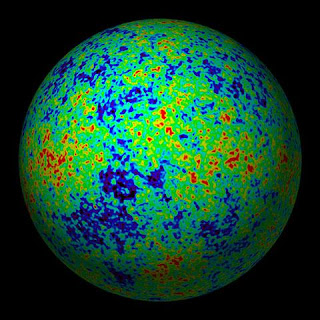We have all seen this picture. We know what it is called. We can say where it comes from. We know the discovery story.
But I asked the question: "Just what is the big deal with the cosmic microwave background?"
Furthermore, How did this serendipitous story of discovery lead to the most significant cosmological experiment to date? I personally felt that there were some critical steps left out of the story that did not allow me to appreciate just how important this measurement is and how the process of discovery *actually* happened. I am going to spend a few posts talking about it. Why? Because it is cool.
The CMB in a nutshell :
- CMB = Cosmic Microwave Background
- The cosmic microwave background is a measurement that the temperature of the entire sky is 2.73 Kelvin = -270.3 Celsius = -454.54 Fahrenheit
- The picture above is a map of the very,very tiny temperature fluctuations in the sky as measured by the WMAP instrument. The colors follow our human intuition of how colors related to different temperatures.* The warmer and cooler colors correspond to warmer and cooler temperatures fluctuations.
- In the very early universe, photons of light could not escape the opaque environment. When the universe expanded and cooled, the environment became transparent enough that photons of light were able to escape. These photons from the very early universe IS the radiation we measure in the microwave regime. (Don't worry, I will provide a much longer explanation of this later!)
- The discovery of the CMB was made by two scientists working at Bell Labs in NJ. The discovery of the excess radiation was made by Penzias and Wilson. The interpretation of what this excess radiation actually is was provided by Peebles, Dicke, and Wilkinson.
- What parameters did the CMB give us? (not a complete list)
- Age of the universe
- Amount of baryons in the universe (all the stuff we are made of and can see!)
- Amount of dark matter
- Amount of dark energy
- The geometry of the universe
- Man that is a lot! What else do you need? More on these parameters too!
I am going to spend a few posts talking about the discovery story, where the CMB photons come from, how to interpret data, and ALL of the cosmological parameters that we get out of the CMB.
Stay tuned!
*This statement of our "human intuition of how colors relate to temperature" is not a good physical way of categorizing a color to temperature relationship. In reality, bluer colors are actually much much hotter than the redder colors. Looking at a flame can confirm this for you. What color is the center of the flame? Is the center of the flame hotter or cooler than the outside of the flame?

No comments:
Post a Comment